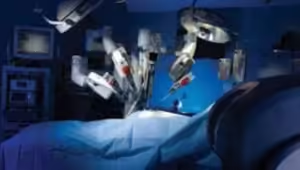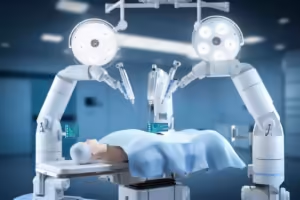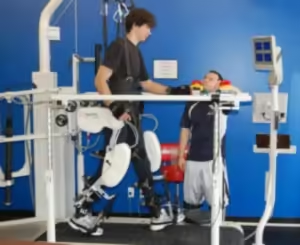Use of Robotics in the Medical Field 2025

In recent years, the use of robotics in the medical field has rapidly advanced, transforming healthcare and bringing about a new era of precision, efficiency, and hope. Have you ever imagined a robot assisting a surgeon during a critical operation or helping a patient with physical therapy? While this might sound futuristic, it’s becoming a reality. Robotics in healthcare doesn’t just improve outcomes; it redefines the way doctors and medical professionals approach patient care. However, how does this actually appear in practice?
To understand the impact of robotics in the medical field, let’s dive deeper. We’ll explore the various ways robots are currently used, the benefits they bring, and what the future might hold.
Introduction
The integration of robotics in the medical field has moved from science fiction to everyday reality. Robotics in healthcare includes various devices and systems designed to perform tasks traditionally done by humans but with greater precision, consistency, and reliability. These applications range from assisting surgeons in complex surgeries to helping patients regain mobility through robotic-assisted rehabilitation.
The Evolution of Medical Robotics

The journey of robotics in medicine began with simple robotic arms used to support surgeries in the late 20th century. Over time, advancements in artificial intelligence (AI), computer vision, and sensor technologies allowed robots to perform increasingly complex tasks. Today, medical robots can be autonomous, semi-autonomous, or remotely operated, and their capabilities continue to grow.
Types of Medical Robots
1. Surgical Robots
Surgical robots are designed to assist surgeons during operations. They provide precision, reduce invasiveness, and improve outcomes.
2. Diagnostic Robots
In order to identify and track illnesses, these robots assist with diagnostic procedures like imaging and analysis.
3. Care Robots
Robots that assist in patient care are invaluable in monitoring patients, administering medications, and helping with daily activities.
4. Rehabilitation Robots
Used in physical therapy, these robots help patients recover mobility and strength after injuries or surgeries.
5. Training Robots
Medical training robots offer a safe, realistic environment for medical professionals to practice their skills.
Robotic-Assisted Surgeries

Precision in Surgery
One of the most transformative uses of robotics is in surgery. Robotic-assisted surgeries offer unmatched precision. Surgeons control the robotic arms, which can perform delicate maneuvers, reducing trauma to surrounding tissues and enhancing recovery times.
Minimally Invasive Procedures
Robotic systems allow for smaller incisions, which means less pain and quicker recovery for patients. Procedures like prostate surgery, heart valve repair, and hip replacements have all benefited from robotic assistance.
Robotics in Diagnostics
Improving Accuracy in Diagnosis
Robots play a crucial role in diagnostics, helping to identify diseases in their early stages. Automated imaging robots provide high-resolution images that help radiologists diagnose conditions accurately.
Speeding Up Diagnostic Processes
With AI-enhanced algorithms, diagnostic robots can analyze images or samples faster than human technicians. This allows for faster diagnosis, which can be lifesaving for critical patients.
Patient Care and Assistance Robots
Monitoring and Medication Assistance
Care robots can monitor vital signs, alerting healthcare professionals if something goes wrong. They can also remind patients to take their medications on time, enhancing compliance and safety.
Helping with Mobility and Daily Activities
For elderly or disabled patients, assistance robots provide mobility support, helping them with daily tasks like eating, dressing, or moving around.This enhances their quality of life and encourages independence.
Rehabilitation and Therapy Robots

Guided Physical Therapy
Robots designed for rehabilitation offer guided physical therapy, which helps patients strengthen their muscles and regain mobility. These robots can adjust therapy intensity based on the patient’s progress.
Improving Recovery Outcomes
By enabling repetitive, consistent exercises, therapy robots play a significant role in speeding up recovery, especially in stroke patients or those with spinal injuries.
Robotics in Medical Training
Simulating Real-Life Scenarios
Robotic systems are used in training environments to simulate surgeries and other medical procedures. This prepares future doctors for real-life situations, improving their confidence and competence.
Reducing Training Risks
With robotic simulations, trainees can practice repeatedly without risking a patient’s well-being. This has become a vital part of medical education, enhancing safety and skill.
Benefits of Robotics in Healthcare
1. Precision and Accuracy
Robots perform with a high level of precision, which minimizes human error and enhances the quality of care.
2. Reduced Recovery Time
Minimally invasive surgeries assisted by robots often result in faster recovery times, getting patients back to their lives sooner.
3. Enhanced Efficiency
Robotics reduce the time needed for procedures and diagnostics, allowing healthcare systems to operate more efficiently.
4. Improved Training and Skill Development
With robots simulating medical scenarios, healthcare professionals receive better training, which translates to improved patient care.
Challenges and Limitations
1. High Costs
Robotics in healthcare can be prohibitively expensive, making it difficult for smaller hospitals to adopt this technology.
2. Technical Limitations
Robots are only as good as the technology that powers them. Limitations in AI and sensors sometimes restrict what medical robots can do.
3. Need for Skilled Operators
Operating medical robots requires specialized training. Without properly trained professionals, the technology may not be used to its full potential.
4. Ethical Considerations
The increasing role of robots in healthcare raises ethical questions about the human element in patient care. This is a complicated topic that needs to be carefully thought out.
Future Prospects
The future of robotics in healthcare is promising, with continuous advancements expected in AI, machine learning, and robotics technology. As robots become more intelligent and autonomous, we can expect them to handle even more aspects of patient care, from complex surgeries to personalized rehabilitation programs.
Conclusion
The use of robotics in the medical field is a powerful force reshaping healthcare. From precision in surgeries to assisting patients in rehabilitation, robots are enhancing the way healthcare is delivered, making it safer, more efficient, and accessible. However, as with any technology, there are challenges and ethical considerations to address. As we look toward a future where robotics becomes even more integrated, the potential for improved patient outcomes and greater accessibility in healthcare seems limitless.
FAQs
- What are the main uses of robotics in the medical field?
Robots are primarily used for surgeries, diagnostics, patient care, rehabilitation, and medical training.
- How do surgical robots assist in operations?
Surgical robots provide precision by translating the surgeon’s movements into smaller, more accurate motions, often allowing for minimally invasive procedures.
- Are medical robots safe for patients?
Yes, medical robots are designed with safety in mind. They are thoroughly tested and operated by trained professionals to ensure patient safety.
- Will robots replace doctors in the future?
No, robots are tools to assist doctors, not replace them. In healthcare, human judgment and touch are still crucial.
- What are the future prospects for robotics in healthcare?
The future holds advancements in AI and machine learning that will make robots more autonomous and capable, potentially expanding their roles in patient care and diagnosis.
Read more : PHP and MySQL Web Development





